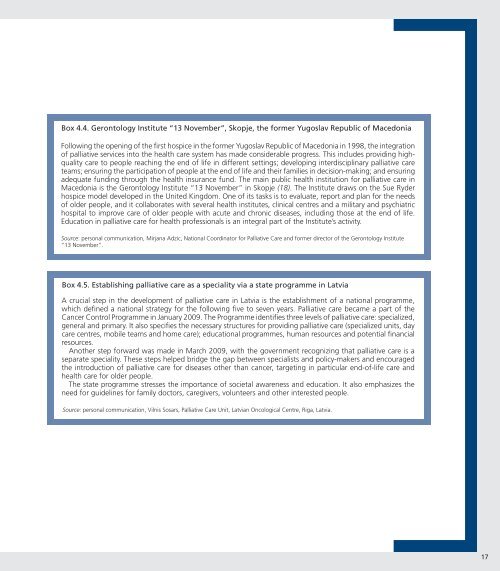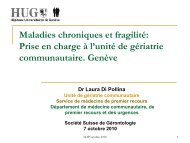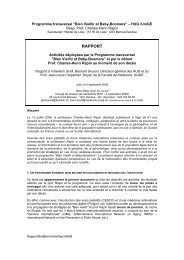Box 4.2. An interdisciplinary task <strong>for</strong>ce on palliative <strong>care</strong> in UkraineProgress has already been made on the development of hospices in Ukraine, and there are plans to developregional and national programmes, palliative <strong>care</strong> registers and additional training <strong>for</strong> doctors and nurses.Access to hospices is not based on prognosis or diagnosis, and they also <strong>care</strong> <strong>for</strong> long-stay <strong>older</strong> <strong>people</strong>. Aninterdisciplinary task <strong>for</strong>ce, including representatives from both government and nongovernmental organizations,has been created in Ukraine. It aims to raise public awareness of palliative <strong>care</strong> throughout society, to createpatient-centred health <strong>care</strong> and to develop palliative <strong>care</strong> legislation. There have been consultations withpatients and the general public along with educational events, such as press conferences and films and radiobroadcasts about patients’ rights and safety. Patient leader groups and in<strong>for</strong>mation and advisory services havebeen established. The task <strong>for</strong>ce has adopted an integrated approach towards planning and delivering palliative<strong>care</strong> by reaching out to regions in Ukraine, religious denominations and members of society. Collaboration is inplace with other European countries to facilitate the exchange of experience in palliative <strong>care</strong>. Partners includeFrance, Poland, the Republic of Moldova and Romania. The Ukrainian interdisciplinary task <strong>for</strong>ce shows thatpalliative <strong>care</strong> can be integrated into a national health <strong>care</strong> system (16).Source: personal communication, Viktor Serdiuk, All-Ukrainian Council <strong>for</strong> Patients’ Rights and Safety.Box 4.3. Humanists Union, a palliative <strong>care</strong> association in Tbilisi, Georgia<strong>Palliative</strong> <strong>care</strong> is a fairly new but rapidly developing discipline within the health <strong>care</strong> system in Georgia. Twonongovernmental organizations, the Cancer Prevention Centre and Humanists’ Union (17), coordinate palliative<strong>care</strong> services. Since palliative <strong>care</strong> emerged in public discussions in 1995, the traditional focus on cancer via theCancer Prevention Centre has gradually shifted to other incurable diseases (with services currently provided<strong>for</strong> inpatient <strong>care</strong> <strong>for</strong> <strong>people</strong> with cancer and HIV and <strong>for</strong> <strong>older</strong> <strong>people</strong> in the framework of the GeorgianHome Care Coalition); more educational programmes, enhanced awareness about symptom control and painmanagement and elaboration of the state policy on drug availability. Work is underway to create a nationalprogramme <strong>for</strong> palliative <strong>care</strong>. The state budget covers 70% of the cost of services.One main goal of the Humanists Union is to promote the development of a palliative <strong>care</strong> system and theimplementation of internationally approved bioethical standards to underpin the creation and success of amodern palliative <strong>care</strong> service in Georgia. The Association has partners, collaborators and supporters from a widerange of government and nongovernmental organizations and international institutions, including Georgia’sMinistry of <strong>Health</strong>, Labour and Social Affairs, the Parliament of Georgia, Tbilisi State Medical University, NationalSociety of the Red Cross, the mass media, San Diego Hospice, the Hungarian <strong>Palliative</strong> Care Association and theHospice Foundation.Significant steps have been taken to raise the awareness and standards of palliative <strong>care</strong>: developingeducational material (handbooks on palliative <strong>care</strong>) <strong>for</strong> medical students; initiating palliative <strong>care</strong> as a universitydiscipline; practical training of health <strong>care</strong> staff members; and creating a mobile team (home-based hospice)providing palliative <strong>care</strong> to <strong>people</strong> with incurable diseases at home.Sources: personal communications, Tamari Rukhadze, Humanists’ Union and Ioseb Abesadze, Cancer Prevention Centre, Tbilisi, Georgia.16
Box 4.4. Gerontology Institute “13 November”, Skopje, the <strong>for</strong>mer Yugoslav Republic of MacedoniaFollowing the opening of the first hospice in the <strong>for</strong>mer Yugoslav Republic of Macedonia in 1998, the integrationof palliative services into the health <strong>care</strong> system has made considerable progress. This includes providing highquality<strong>care</strong> to <strong>people</strong> reaching the end of life in different settings; developing interdisciplinary palliative <strong>care</strong>teams; ensuring the participation of <strong>people</strong> at the end of life and their families in decision-making; and ensuringadequate funding through the health insurance fund. The main public health institution <strong>for</strong> palliative <strong>care</strong> inMacedonia is the Gerontology Institute “13 November” in Skopje (18). The Institute draws on the Sue Ryderhospice model developed in the United Kingdom. One of its tasks is to evaluate, report and plan <strong>for</strong> the needsof <strong>older</strong> <strong>people</strong>, and it collaborates with several health institutes, clinical centres and a military and psychiatrichospital to improve <strong>care</strong> of <strong>older</strong> <strong>people</strong> with acute and chronic diseases, including those at the end of life.Education in palliative <strong>care</strong> <strong>for</strong> health professionals is an integral part of the Institute’s activity.Source: personal communication, Mirjana Adzic, National Coordinator <strong>for</strong> <strong>Palliative</strong> Care and <strong>for</strong>mer director of the Gerontology Institute“13 November”.Box 4.5. Establishing palliative <strong>care</strong> as a speciality via a state programme in LatviaA crucial step in the development of palliative <strong>care</strong> in Latvia is the establishment of a national programme,which defined a national strategy <strong>for</strong> the following five to seven years. <strong>Palliative</strong> <strong>care</strong> became a part of theCancer Control Programme in January 2009. The Programme identifies three levels of palliative <strong>care</strong>: specialized,general and primary. It also specifies the necessary structures <strong>for</strong> providing palliative <strong>care</strong> (specialized units, day<strong>care</strong> centres, mobile teams and home <strong>care</strong>); educational programmes, human resources and potential financialresources.Another step <strong>for</strong>ward was made in March 2009, with the government recognizing that palliative <strong>care</strong> is aseparate speciality. These steps helped bridge the gap between specialists and policy-makers and encouragedthe introduction of palliative <strong>care</strong> <strong>for</strong> diseases other than cancer, targeting in particular end-of-life <strong>care</strong> andhealth <strong>care</strong> <strong>for</strong> <strong>older</strong> <strong>people</strong>.The state programme stresses the importance of societal awareness and education. It also emphasizes theneed <strong>for</strong> guidelines <strong>for</strong> family doctors, <strong>care</strong>givers, volunteers and other interested <strong>people</strong>.Source: personal communication, Vilnis Sosars, <strong>Palliative</strong> Care Unit, Latvian Oncological Centre, Riga, Latvia.17
















